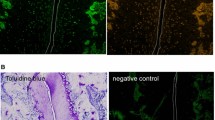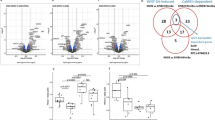Abstract
The matricellular protein Wnt-induced secreted protein 1 (WISP1) is the fourth member of the CCN family of proteins, which has been shown to affect tissues of the musculoskeletal system. In the context of the musculoskeletal disorder osteoarthritis, our lab studied the function of CCN4/WISP1 in joint tissues, including synovium and cartilage, using both gain- and loss-of-function approaches. In mice, this was done by genetic engineering and recombination to generate mice deficient in CCN4/WISP1 protein. Various experimental models of osteoarthritis with different characteristics were induced in these mice. Moreover, CCN4/WISP1 levels in joints were experimentally increased by adenoviral transfections. Osteoarthritis pathology was determined using histology, and the effect of different CCN4/WISP1 levels on gene expression was evaluated in individual tissues. Effects of high levels of CCN4/WISP1 on chondrocytes were studied with an in vitro chondrocyte pellet model. In this chapter, we describe the procedures to conduct these experiments.
Access this chapter
Tax calculation will be finalised at checkout
Purchases are for personal use only
Similar content being viewed by others
References
Loeser RF, Goldring SR, Scanzello CR, Goldring MB (2012) Osteoarthritis: a disease of the joint as an organ. Arthritis Rheum 64(6):1697–1707
Samuels J, Krasnokutsky S, Abramson SB (2008) Osteoarthritis: a tale of three tissues. Bull NYU Hosp Jt Dis 66(3):244–250
Lories RJ, Monteagudo S (2020) Review article: is Wnt signaling an attractive target for the treatment of osteoarthritis? Rheumatol Ther 7(2):259–270
Chen CC, Lau LF (2009) Functions and mechanisms of action of CCN matricellular proteins. Int J Biochem Cell Biol 41(4):771–783
Jun JI, Lau LF (2011) Taking aim at the extracellular matrix: CCN proteins as emerging therapeutic targets. Nat Rev Drug Discov 10(12):945–963
Inkson CA, Ono M, Bi Y, Kuznetsov SA, Fisher LW, Young MF (2009) The potential functional interaction of biglycan and WISP-1 in controlling differentiation and proliferation of osteogenic cells. Cells Tissues Organs 189(1–4):153–157
Walton M (1977) Degenerative joint disease in the mouse knee; histological observations. J Pathol 123(2):109–122
Blom AB, Brockbank SM, van Lent PL, van Beuningen HM, Geurts J, Takahashi N et al (2009) Involvement of the Wnt signaling pathway in experimental and human osteoarthritis: prominent role of Wnt-induced signaling protein 1. Arthritis Rheum 60(2):501–512
Maeda A, Ono M, Holmbeck K, Li L, Kilts TM, Kram V et al (2015) WNT1-induced secreted protein-1 (WISP1), a novel regulator of bone turnover and Wnt signaling. J Biol Chem 290(22):14004–14018
van den Bosch MH, Blom AB, Kram V, Maeda A, Sikka S, Gabet Y et al (2017) WISP1/CCN4 aggravates cartilage degeneration in experimental osteoarthritis. Osteoarthr Cartil 25(11):1900–1911
van den Bosch MH, Blom AB, Sloetjes AW, Koenders MI, van de Loo FA, van den Berg WB et al (2015) Induction of canonical Wnt signaling by synovial overexpression of selected Wnts leads to protease activity and early osteoarthritis-like cartilage damage. Am J Pathol 185(7):1970–1980
van den Bosch MHJ, Ramos YFM, den Hollander W, Bomer N, Nelissen R, Bovee J et al (2019) Increased WISP1 expression in human osteoarthritic articular cartilage is epigenetically regulated and decreases cartilage matrix production. Rheumatology (Oxford) 58(6):1065–1074
Jay GE Jr, Sokoloff L (1956) Natural history of degenerative joint disease in small laboratory animals. II. Epiphyseal maturation and osteoarthritis of the knee of mice of inbred strains. AMA Arch Pathol 62(2):129–135
van Osch GJ, van der Kraan PM, Vitters EL, Blankevoort L, van den Berg WB (1993) Induction of osteoarthritis by intra-articular injection of collagenase in mice. Strain and sex related differences. Osteoarthr Cartil 1(3):171–177
Glasson SS, Blanchet TJ, Morris EA (2007) The surgical destabilization of the medial meniscus (DMM) model of osteoarthritis in the 129/SvEv mouse. Osteoarthr Cartil 15(9):1061–1069
Kamekura S, Hoshi K, Shimoaka T, Chung U, Chikuda H, Yamada T et al (2005) Osteoarthritis development in novel experimental mouse models induced by knee joint instability. Osteoarthr Cartil 13(7):632–641
Glasson SS, Chambers MG, Van Den Berg WB, Little CB (2010) The OARSI histopathology initiative – recommendations for histological assessments of osteoarthritis in the mouse. Osteoarthr Cartil 18(Suppl 3):S17–S23
van Osch GJ, van der Kraan PM, van den Berg WB (1994) Site-specific cartilage changes in murine degenerative knee joint disease induced by iodoacetate and collagenase. J Orthop Res 12(2):168–175
Acknowledgments
The work presented here was supported in part by the Intramural Research Program of the NIH, NIDCR (Funding number 1 Z01 DE000379-21), and was financially supported by a grant from the Dutch Arthritis Foundation (Grant Number 08-1-309), a short-term fellowship from the European Molecular Biology Organization (Grant Number ASTF 578-2014), and by the ZonMW/VENI Research Program (project number 09150161810015), which is financed by the Dutch Research Council (NWO).
Author information
Authors and Affiliations
Corresponding author
Editor information
Editors and Affiliations
Rights and permissions
Copyright information
© 2023 The Author(s), under exclusive license to Springer Science+Business Media, LLC, part of Springer Nature
About this protocol
Cite this protocol
van den Bosch, M.H.J., Blaney Davidson, E.N. (2023). Analysis of CCN4/WISP1 Effects on Joint Tissues Using Gain- and Loss-of-Function Approaches. In: Takigawa, M. (eds) CCN Proteins. Methods in Molecular Biology, vol 2582. Humana, New York, NY. https://doi.org/10.1007/978-1-0716-2744-0_26
Download citation
DOI: https://doi.org/10.1007/978-1-0716-2744-0_26
Published:
Publisher Name: Humana, New York, NY
Print ISBN: 978-1-0716-2743-3
Online ISBN: 978-1-0716-2744-0
eBook Packages: Springer Protocols




